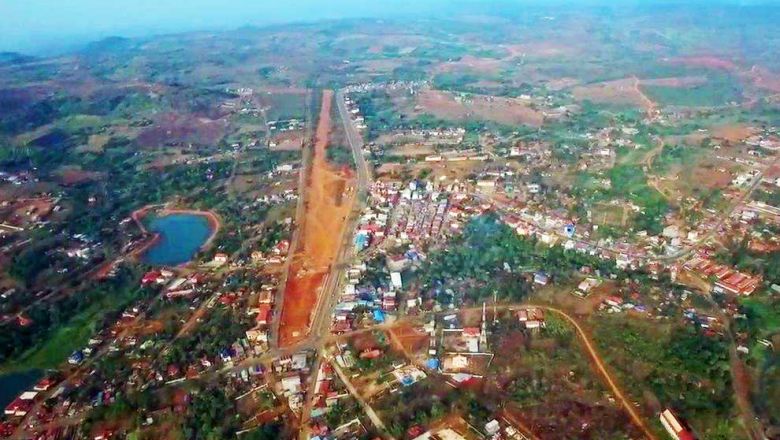In its push for coal-fired mega-projects, the government risks turning its back on sufficiency-economy thinking and the need for ‘clean’ energy
We are in the countdown to the United Nations Climate Change Conference, to be held in Paris from November 30 to December 11. This is the 21st session of the Conference of the Parties (COP 21) to the 1992 United Nations Framework Convention on Climate Change. Thailand, now ranked 23rd of carbon dioxide polluters, potentially has a key mission – to exemplify the role a socially and environmentally responsible medium-sized economy can play.
The objective of COP 21 is to achieve, for the first time, a binding and universal climate agreement to prevent the world’s temperature rising by more than two degrees centigrade by 2030, a change seen as catastrophic and irreversible – and one that would likely lead to the loss of Bangkok as a capital city. One major OECD study indicates that by 2070 Bangkok will lie seventh among cities most exposed to the effects of climate change (including all environmental and socio-economic factors). Because of the size of Bangkok, the effect on the national economy is expected to be disastrous.
The COP 21 mechanism is intended to be a network of “Intended Nationally Determined Contributions”, ie, solid commitments on reducing carbon output – a commitment Thailand has yet to make. In line with most economies, Thailand’s carbon dioxide pollution output has risen sharply, from 90,766 kilotonnes emitted in 1990 to 262,228 kilotonnes in 2013, according to the Emission Database for Global Atmospheric Research – a 289 per cent increase.
However, Thailand’s energy future under the military junta seems to already be set. According to the new Power Development Plan for 2015-2036, the country is locked into a future based on another 20 gas power stations (17,728 MWe), another nine “clean coal” power stations (7,390 MWe), then 14,206 MW of renewable energy, including hydro, a large proportion of which will be imported from Laos or Myanmar. Up to two nuclear plants are also scheduled, which will be a complete step into the unknown for Thailand, especially considering that the majority of accidents at nuclear plants are due to the human factor – poor training and maintenance.
Moreover, the country does not actually need this much power. Thailand plans for a reserve margin – the amount of energy available over that used at peak demand – of 15 per cent. However, the Plan implies reserve margins as high as 39 per cent in some years. The problem is that Thailand regularly overestimates its economic growth, assuming it to be over 4 per cent when it is historically around 3 per cent.
Another problem is the role of imported hydro. At the moment, hydro accounts for approximately 7 per cent of the load. Under the plan, it will rise to 15-20 per cent by 2036, and additional hydro will be imported from the Xayaburi Dam on the Mekong River and from the Hat Gyi and Mong Ton dams in Myanmar, both of which involve Thailand in the construction process. All these are predicted to have severe social consequences for ethnic minorities. And, while these sources may look “clean” on Thailand’s balance sheets, the devastating environmental impacts are simply being outsourced.
Thailand’s decision to go ahead with a massive new coal-fired power station in Krabi, a 315MWe Bt48-billion affair, as well as another in Lampang, also presents a serious problem. Coal is a major source of mercury poisoning and has been found in toxic amounts up to 12 times more than the maximum acceptable dose in the inhabitants of Tha Thum in Prachin Buri, with possible vectors being fly ash from the local coal power plant, coal dust from outdoor coal storage piles, or coal ash, used as fertiliser. These present risks to Krabi’s tourism industry and have provoked hunger strikes.
Furthermore, “clean-coal” technology is still in a nascent stage and at the moment can only handle sulphur dioxide, nitrogen oxides and particulates – carbon dioxide sequestering is much more complex and costly.
This raises the question of why Thailand wants to build a few very large coal power plants when it should be following safer, quite possibly cheaper routes, such as biomass reactors, like the 40MWe plant operated by Double A in Prachin Buri using wood and offcuts. Quite simply, large, centralised mega-projects are favoured in Thailand. They benefit the centralised system of project approval, and with a public sector corruption rate of 25 per cent, according to the Thai Chamber of Commerce, they can be very beneficial for unscrupulous officials.
While the authors are not alleging any kind of corruption in the case of the Krabi power plant, one tenderer, a partnership of the French company Alstom and the Japanese company Marubeni, requires scrutiny. Alstom, a large multinational electricity generation and rail company, was fined US$772 million in 2014 in relation to allegations it used bribes to obtain contracts in Indonesia, Saudi Arabia and Egypt. In the last two years, it has also faced allegations of bribery in India, Poland, Tunisia, Lithuania and Hungary. Marubeni is the fifth-largest Japanese general trading company and was Alstom’s partner in the Indonesian power-plant bribery case, following previous allegations of bribery in Nigeria, successfully prosecuted by the US under the Foreign Corrupt Practices Act.
Another reason for centralised coal over distributed co-generation or renewables is to encourage the development of Thai companies and partnerships, as in the second consortium, a partnership between Italian-Thai, Thailand’s largest construction company, responsible for Bangkok’s MRT Blue Line, and the Power Construction Corporation. The latter is a subsidiary of Sinohydro Corporation, a Chinese state-owned power company, and thus the partnership may represent a practice run between the well-established Thai company and China for Thailand’s proposed high-speed rail network.
Thailand presents itself to the world as a majority-Buddhist country, one inspired by a philosophy of moderation – the philosophy of sufficiency economy, now one of the “12 Core Values of Thai People”. However, in order for this sentiment to ring true, it needs to moderate its energy planning and embrace alternatives, such as the “Low-Carbon Society Vision 2030”, co-ordinated by Thammasat University’s Sirindhorn International Institute of Technology.
Source: http://www.nationmultimedia.com/opinion/Thailands-power-dilemma-amid-a-climate-of-fear-30267497.html

